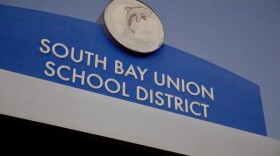You must be at full attention when driving down Park Boulevard in University Heights. It’s busy, so there’s little room for error. As we pull alongside a bicyclist, I rolled down my window and asked if he’s excited about the bike lanes the city is creating for cyclists like him.
"Thumbs up?" I said.
He hesitated to respond.
"We’ll see once they’re in. I’m not too sure," he said, before agreeing to pull over to give us more insight.
His name is Guido Hamacher. He said he lives in the neighborhood and bikes daily to take his son to school, run errands and work out. He said adding bike lanes could work, but on parallel streets with less traffic and not impossible to go to his favorite local hangouts.
"I hope they work for everyone because I think the businesses are going to be negatively impacted by all this," he said. "I’m torn about it, because on the one hand, I see what is supposed to be achieved. They’re looking for safety for the bikers, [to] create a safe space. Sometimes I feel, you know, not safe on the road and so I understand that aspect. But... I also drive a car, and I feel a lot of the businesses are being impacted by [customers] not being able to swing by and park because parking spaces are gone... I don’t know how this is all going to play out in the long run."
When we visited the area packed with businesses and spoke with people eating, shopping and working there, including business owners, we couldn't find a person with anything nice to say about the bike lanes in progress.
"Definitely not pleased or excited about them at all," said Rob DeRieux, a stylist at Park Salon, who was busy adding the perfect highlights to his client's hair, but not too busy to tell us how terrible the lanes have been for them and people who live there.
He said removing parking for the bike lanes is not just inconvenient, but also bad for business. He said the city needs to come up with a more creative solution that will be a fit for the neighborhood.
"It’s definitely concerning for the neighborhood and all of the businesses on this street because on a normal day you’ll see a lot of traffic, " he said. "Taking those spots away is going to create a world of congestion and it just doesn’t make sense, because we have surface streets on each side that are perfectly capable of facilitating the bike lanes or alternative for the bikers. This is a main artery of traffic through this neighborhood, and so it makes absolutely no sense."
But Will Rhatigan with the Bike Coalition of San Diego County said the change will be worth it to save lives. He said 16 cyclists were killed last year in the city.
"The number one reason for putting a bikeway in is to save lives and I think again no amount of parking spaces is worth someone’s life," he said.
Rhatigan said in reality only 10% of the parking will shift to side streets and thinks people are scared of change. "They don’t realize that these bikeways aren’t as bad as they seem," he said. "We’ve seen over and over that people are really scared and confused before these bikeways go in. But once they’re installed, within a few months they realize the sky hasn’t fallen, they can actually still drive where they need to go pretty easily, but now everyone’s a little bit safer."
We reached out to Mayor Todd Gloria's office. He could not give us an interview but Dave Rolland, his deputy director of communications, sent a statement noting the bike lanes on Park Boulevard were called for in three different plans which each got significant public input and review.
Rolland also wrote, "The design of the bike lane retains most of the existing parking and we are actively working with the community to identify opportunities to add parking on side streets to make up for the lost spaces ... Studies show that complete streets equipped with features that make travel safer for pedestrians and bike riders are good for business, public safety and quality of life."
The project will continue through Balboa Park in the fall.








